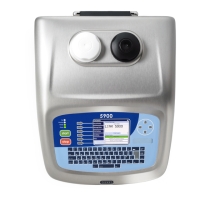Page 17 of 25 FA69372–2 English
Jun 2013
25
How To Install and Set Up the 5900 &
7900 Printer
Linx 5900 & 7900
3.1.3 Summary
1. Calculate:
2. Refer to the tables in the section ‘Ideal Raster Pitch tables’ to get the Ideal Raster Pitch
for your printhead and message type.
3. Calculate:
4. Calculate:
* This value is calculated to the nearest whole number.
5. Calculate:
Actual Raster Pitch = Encoder Pitch x Pitch Factor
6. Calculate:
Printed Message Length = Number of Rasters x Actual Raster Pitch
Make sure that the Printed Message Length is less than the Printed Length in step 1.
7. Calculate the Maximum Print Speed for this message type:
Maximum Print Speed = Actual Raster Pitch x Raster Rate
8. Calculate:
Maximum Encoder Speed = Encoder Pitch x Maximum Encoder Frequency
(Maximum Encoder Frequency is 80 kHz for Linx standard encoders.)
9. Make sure that the Maximum Line Speed (step 7) is less than the Maximum Encoder
Speed (step 8).
10. Make sure that the line speed is never greater than either the Maximum Print Speed or
the Maximum Encoder Speed.
11. At the Speed page, enter the Encoder Speed value (pulses/mm) for the encoder and
wheel combination.
12. At the Print Settings page, set the Print Width parameter to the value that you
calculated for the Actual Raster Pitch (step 5).
13. Check the print performance.
Required Raster Pitch =
Printed Length
Number of Rasters in Message
Encoder Pitch =
Encoder wheel circumference
Encoder pulses per revolution
Pitch Factor* =
Required Raster Pitch
Encoder Pitch

